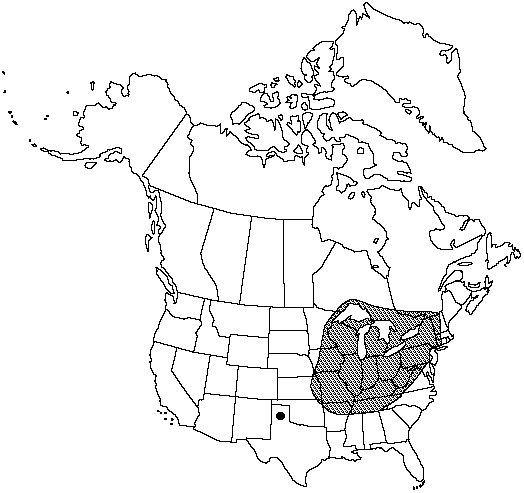Difference between revisions of "Pellaea glabella subsp. glabella"
FNA>Volume Importer |
imported>Volume Importer |
||
| (6 intermediate revisions by 2 users not shown) | |||
| Line 3: | Line 3: | ||
|accepted_authority=Mettenius ex Kuhn | |accepted_authority=Mettenius ex Kuhn | ||
|publications= | |publications= | ||
| + | |special_status={{Treatment/ID/Special_status | ||
| + | |code=E | ||
| + | |label=Endemic | ||
| + | }} | ||
|basionyms= | |basionyms= | ||
|synonyms={{Treatment/ID/Synonym | |synonyms={{Treatment/ID/Synonym | ||
|name=Pellaea atropurpurea var. bushii | |name=Pellaea atropurpurea var. bushii | ||
|authority=Mackenzie | |authority=Mackenzie | ||
| + | |rank=variety | ||
}} | }} | ||
|hierarchy=Pteridaceae;Pellaea;Pellaea glabella;Pellaea glabella subsp. glabella | |hierarchy=Pteridaceae;Pellaea;Pellaea glabella;Pellaea glabella subsp. glabella | ||
| Line 22: | Line 27: | ||
|elevation=0–1200 m | |elevation=0–1200 m | ||
|distribution=Ont.;Que.;Ark.;Conn.;Ill.;Ind.;Iowa;Kans.;Ky.;Md.;Mass.;Mich.;Minn.;Mo.;Nebr.;N.Y.;Ohio;Okla.;Pa.;Tenn.;Tex.;Vt.;Va.;W.Va.;Wis. | |distribution=Ont.;Que.;Ark.;Conn.;Ill.;Ind.;Iowa;Kans.;Ky.;Md.;Mass.;Mich.;Minn.;Mo.;Nebr.;N.Y.;Ohio;Okla.;Pa.;Tenn.;Tex.;Vt.;Va.;W.Va.;Wis. | ||
| − | |discussion=<p>G. J. Gastony (1988) has shown that this apogamous tetraploid was derived from Pellaea glabella subsp. missouriensis by an autopolyploid increase in chromosome number.</p> | + | |discussion=<p>G. J. Gastony (1988) has shown that this apogamous tetraploid was derived from <i>Pellaea glabella </i>subsp.<i> missouriensis</i> by an autopolyploid increase in chromosome number.</p> |
|tables= | |tables= | ||
|references= | |references= | ||
| Line 31: | Line 36: | ||
-->{{#Taxon: | -->{{#Taxon: | ||
name=Pellaea glabella subsp. glabella | name=Pellaea glabella subsp. glabella | ||
| − | |||
|authority=Mettenius ex Kuhn | |authority=Mettenius ex Kuhn | ||
|rank=subspecies | |rank=subspecies | ||
| Line 45: | Line 49: | ||
|publication title= | |publication title= | ||
|publication year= | |publication year= | ||
| − | |special status= | + | |special status=Endemic |
| − | |source xml=https:// | + | |source xml=https://bitbucket.org/aafc-mbb/fna-data-curation/src/2e0870ddd59836b60bcf96646a41e87ea5a5943a/coarse_grained_fna_xml/V2/V2_766.xml |
|genus=Pellaea | |genus=Pellaea | ||
|species=Pellaea glabella | |species=Pellaea glabella | ||
Latest revision as of 20:25, 5 November 2020
Some ultimate segments (especially terminal segments) with hairlike scales abaxially near midrib; most sporangia containing 32 spores; spores averaging 60–72 µm diam. n = 2n = 116, apogamous.
Phenology: Sporulating summer–fall.
Habitat: Calcareous cliffs and ledges, usually on limestone substrates
Elevation: 0–1200 m
Distribution

Ont., Que., Ark., Conn., Ill., Ind., Iowa, Kans., Ky., Md., Mass., Mich., Minn., Mo., Nebr., N.Y., Ohio, Okla., Pa., Tenn., Tex., Vt., Va., W.Va., Wis.
Discussion
G. J. Gastony (1988) has shown that this apogamous tetraploid was derived from Pellaea glabella subsp. missouriensis by an autopolyploid increase in chromosome number.
Selected References
None.
Lower Taxa
None.